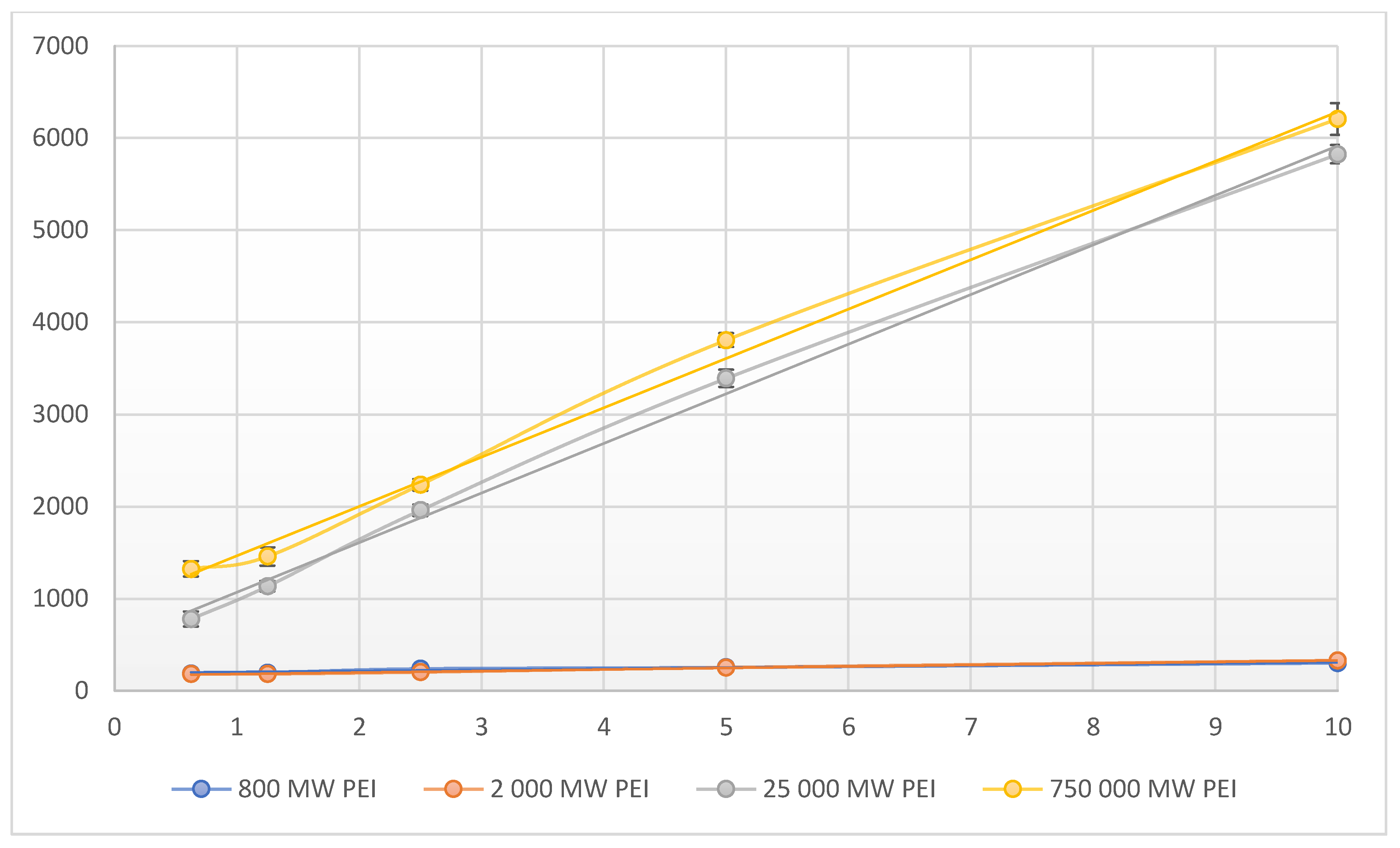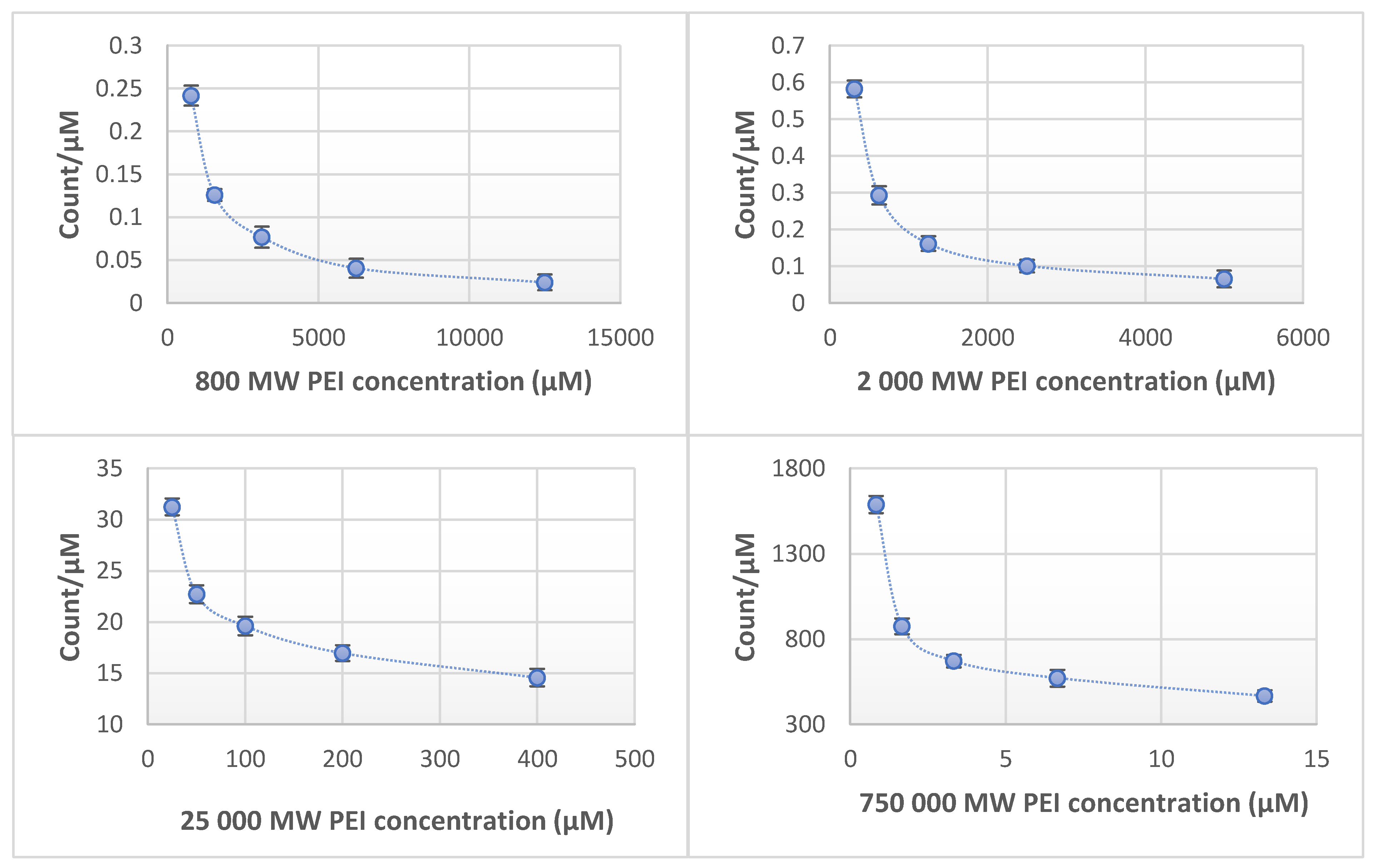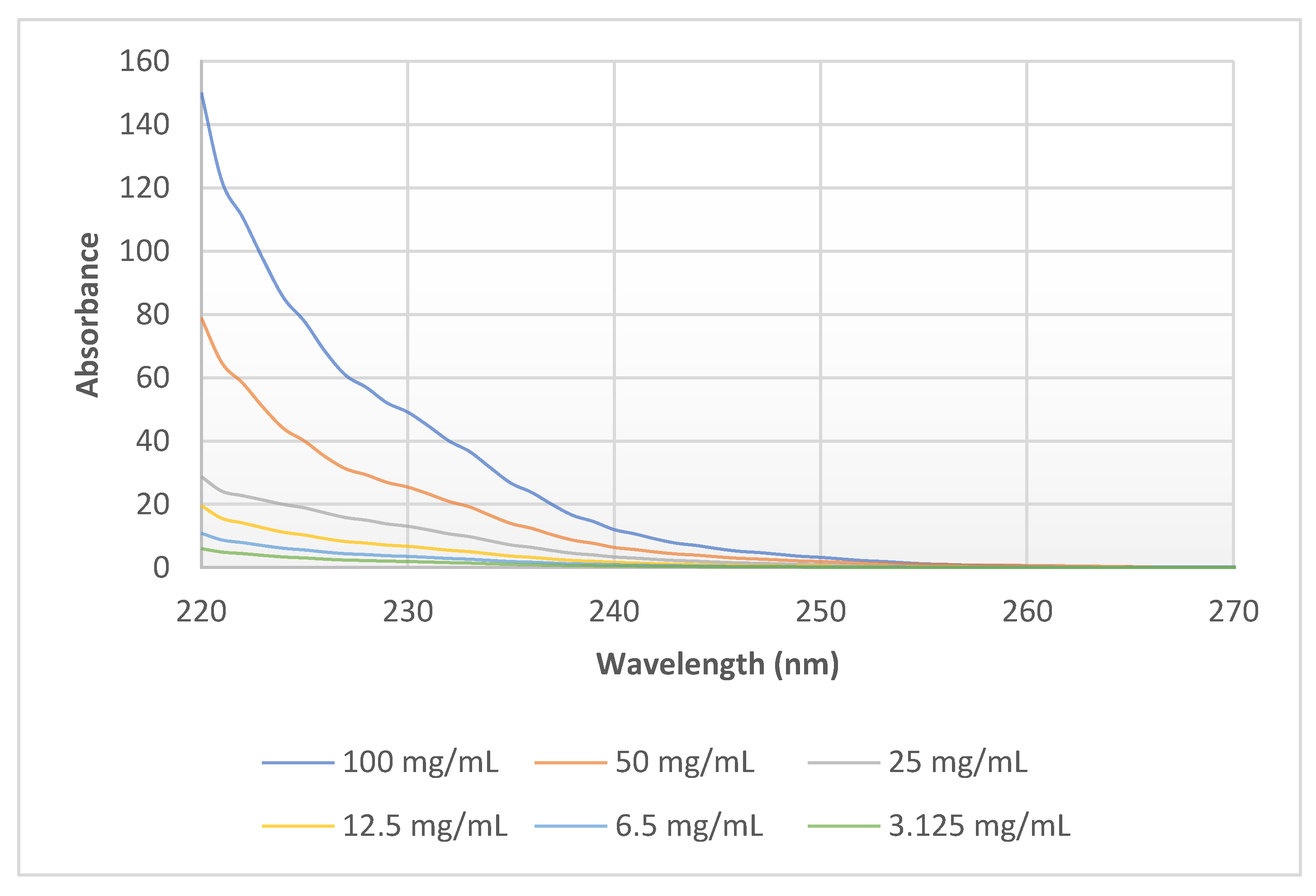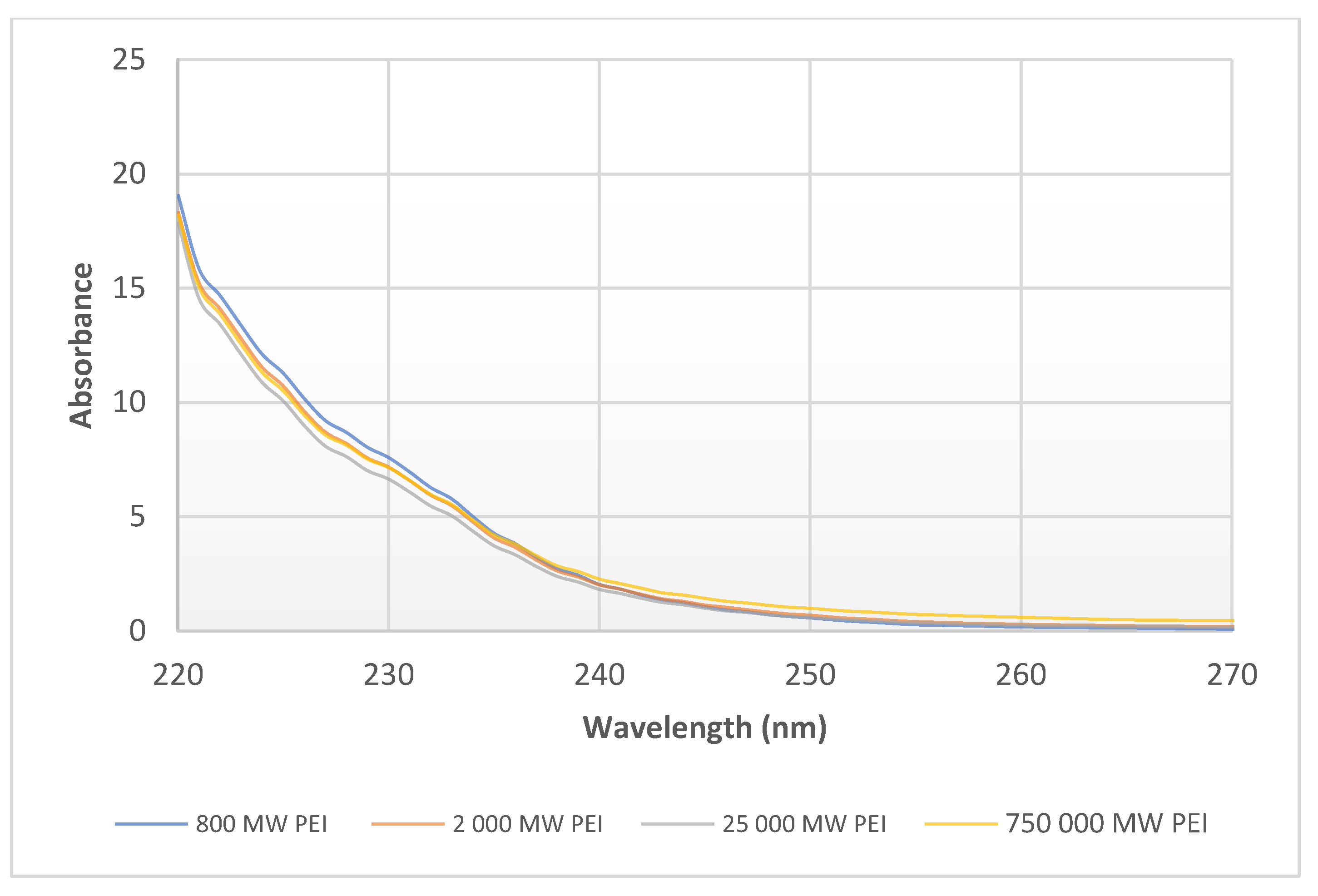Study of the Intrinsic Fluorescence of a Highly Branched Cationic Dendrimer, Poly(Ethyleneimine) (PEI)
Abstract
1. Introduction
2. Results
2.1. The Measurement of Fluorescence of PEI Dilution Series with Different Molecular Weights
2.2. The pH Measurements of PEI Dilution Series
2.3. The Measurement of Absorbance of PEI
3. Discussion
- The molecular weight is the primarily accountable property of the given polymers. It is especially true for the PEI, whose structure is built up according to so-called ‘generations’, like layers of an onion (onion-like structure). In every additional shell, the number of terminal amino groups may redouble. This is the reason why the number of reactive amino groups increases gradually. From generation to generation the synthesis increases in difficulty and cost. After the fifth generation, the branches may lean back and create intermolecular connections.
- The pH of the solution basically determines the degree of protonation of amino groups [15]. The primary- and tertiary-amine groups’ protonation mechanism can explain the higher fluorescence emission phenomena of PEI at low pH.
4. Materials and Methods
4.1. Materials
4.2. Fluorescence Measurements of PEI Dilution Series
| Measurement type: | Wavelength Scan |
| Scan mode: | Emission |
| Data mode: | Fluorescence |
| EX WL: | 280.0 nm |
| EM Start WL: | 290.0 nm |
| EM End WL: | 720.0 nm |
| Scan speed: | 1200 nm/min |
| Delay: | 0 s |
| EX Slit: | 5.0 nm |
| EM Slit: | 5.0 nm |
| PMT Voltage: | 700 V |
| Response: | Auto |
4.3. The pH and Fluorescent Measurements of 25 kPEI Dilution Series
4.4. Absorption Measurements of PEI Dilution Series
5. Conclusions
Author Contributions
Funding
Acknowledgments
Conflicts of Interest
References
- Boussif, O.; Lezoualc’h, F.; Zanta, M.A.; Mergny, M.D.; Scherman, D.; Demeneix, B.; Behr, J.P. A versatile vector for gene and oligonucleotide transfer into cells in culture and in vivo: Polyethylenimine. Proc. Natl. Acad. Sci. USA 1995, 92, 7297–7301. [Google Scholar] [CrossRef] [PubMed]
- Mulens-Arias, V.; Nicolás-Boluda, A.; Gehanno, A.; Balfourier, A.; Carn, F.; Gazeau, F. Polyethyleneimine-assisted one-pot synthesis of quasi-fractal plasmonic gold nanocomposites as a photothermal theranostic agent. Nanoscale 2019, 11, 3344–3359. [Google Scholar] [CrossRef] [PubMed]
- Courtright, B.A.E.; Jenekhe, S.A. Polyethylenimine interfacial layers in inverted organic photovoltaic devices: Effects of ethoxylation and molecular weight on efficiency and temporal stability. ACS Appl. Mater. Interfaces 2015, 7, 26167–26175. [Google Scholar] [CrossRef] [PubMed]
- Luo, J.; Li, C.; Chen, J.; Wang, G.; Gao, R.; Gu, Z. An efficient method for in vitro gene delivery via regulation of cellular endocytosis pathway. Int. J. Nanomedicine 2015, 10, 1667–1678. [Google Scholar] [PubMed]
- Baumann, F.E.; Haeger, H.; Novikova, O.; Oenbrink, G.; Richter, R. Method for the determination of primary, secondary, and tertiary amino groups in star-shaped polyamide 12 with a poly(ethylene imine) core. J. Appl. Polym. Sci. 2005, 95, 556–563. [Google Scholar] [CrossRef]
- Azevedo, M.M.; Ramalho, P.; Silva, A.P.; Teixeira-Santos, R.; Pina-Vaz, C.; Rodrigues, A.G. Polyethyleneimine and polyethyleneimine-based nanoparticles: Novel bacterial and yeast biofilm inhibitors. J. Med. Microbiol. 2014, 63, 1167–1173. [Google Scholar] [CrossRef] [PubMed]
- Géczi, Z.; Hermann, P.; Kőhidai, L.; Láng, O.; Kőhidai, Z.; Mészáros, T.; Barócsi, A.; Lenk, S.; Zelles, T. Antimicrobial silver-polyethyleneimine-polylactic acid polymer composite film for coating methacrylate-based denture surfaces. J. Nanomater. 2018, 2018, 1–9. [Google Scholar] [CrossRef]
- Liu, S.G.; Li, N.; Ling, Y.; Kang, B.H.; Geng, S.; Li, N.B.; Luo, H.Q. PH-mediated fluorescent polymer particles and gel from hyperbranched polyethylenimine and the mechanism of intrinsic fluorescence. Langmuir 2016, 32, 1881–1889. [Google Scholar] [CrossRef] [PubMed]
- Ungaro, F.; De Rosa, G.; Miro, A.; Quaglia, F. Spectrophotometric determination of polyethylenimine in the presence of an oligonucleotide for the characterization of controlled release formulations. J. Pharm. Biomed. Anal. 2003, 31, 143–149. [Google Scholar] [CrossRef]
- Brankova, T.; Bekiari, V.; Lianos, P. Photoluminescence from sol−gel organic/inorganic hybrid gels obtained through carboxylic acid solvolysis. Chem. Mater. 2003, 15, 1855–1859. [Google Scholar] [CrossRef]
- Zhang Yuan, W.; Zhang, Y. Nonconventional macromolecular luminogens with aggregation-induced emission characteristics. J. Polym. Sci. Part A Polym. Chem. 2017, 55, 560–574. [Google Scholar] [CrossRef]
- Ji, Y.; Qian, Y. A study using quantum chemical theory methods on the intrinsic fluorescence emission and the possible emission mechanisms of pamam. RSC Adv. 2014, 4, 58788–58794. [Google Scholar] [CrossRef]
- Xu, D.; Wang, Q.; Yang, T.; Cao, J.; Lin, Q.; Yuan, Z.; Li, L. Polyethyleneimine capped silver nanoclusters as efficient antibacterial agents. Int. J. Environ. Res. Public Health 2016, 13, 334. [Google Scholar] [CrossRef] [PubMed]
- Koper, G.J.; van Duijvenbode, R.C.; Stam, D.D.; Steuerle, U.; Borkovec, M. Synthesis and protonation behavior of comblike poly(ethyleneimine). Macromolecules 2003, 36, 2500–2507. [Google Scholar] [CrossRef]
- Suh, J.; Paik, H.J.; Hwang, B.K. Ionization of poly(ethylenimine) and poly(allylamine) at various ph′s. Bioorg. Chem. 1994, 22, 318–327. [Google Scholar] [CrossRef]
- Pastor-Pérez, L.; Chen, Y.; Shen, Z.; Lahoz, A.; Stiriba, S.E. Unprecedented blue intrinsic photoluminescence from hyperbranched and linear polyethylenimines: Polymer architectures and ph-effects. Macromol. Rapid Commun. 2007, 28, 1404–1409. [Google Scholar] [CrossRef]
- Chen, Y.; Zhang, Y. Fluorescent quantification of amino groups on silica nanoparticle surfaces. Anal. Bioanal. Chem. 2011, 399, 2503–2509. [Google Scholar] [CrossRef] [PubMed]
- Liu, M.; Li, J.; Li, B. Mannose-modificated polyethylenimine: A specific and effective antibacterial agent against escherichia coli. Langmuir 2018, 34, 1574–1580. [Google Scholar] [CrossRef] [PubMed]
- Morimoto, K.; Nishikawa, M.; Kawakami, S.; Nakano, T.; Hattori, Y.; Fumoto, S.; Yamashita, F.; Hashida, M. Molecular weight-dependent gene transfection activity of unmodified and galactosylated polyethyleneimine on hepatoma cells and mouse liver. Mol. Therapy 2003, 7, 254–261. [Google Scholar] [CrossRef]
Sample Availability: Samples of the PEI dilution series are available from the authors. |





© 2019 by the authors. Licensee MDPI, Basel, Switzerland. This article is an open access article distributed under the terms and conditions of the Creative Commons Attribution (CC BY) license (http://creativecommons.org/licenses/by/4.0/).
Share and Cite
Tóth, V.; Hermann, P.; Végh, D.; Zelles, T.; Géczi, Z. Study of the Intrinsic Fluorescence of a Highly Branched Cationic Dendrimer, Poly(Ethyleneimine) (PEI). Molecules 2019, 24, 3690. https://doi.org/10.3390/molecules24203690
Tóth V, Hermann P, Végh D, Zelles T, Géczi Z. Study of the Intrinsic Fluorescence of a Highly Branched Cationic Dendrimer, Poly(Ethyleneimine) (PEI). Molecules. 2019; 24(20):3690. https://doi.org/10.3390/molecules24203690
Chicago/Turabian StyleTóth, Viktória, Péter Hermann, Dániel Végh, Tivadar Zelles, and Zoltán Géczi. 2019. "Study of the Intrinsic Fluorescence of a Highly Branched Cationic Dendrimer, Poly(Ethyleneimine) (PEI)" Molecules 24, no. 20: 3690. https://doi.org/10.3390/molecules24203690
APA StyleTóth, V., Hermann, P., Végh, D., Zelles, T., & Géczi, Z. (2019). Study of the Intrinsic Fluorescence of a Highly Branched Cationic Dendrimer, Poly(Ethyleneimine) (PEI). Molecules, 24(20), 3690. https://doi.org/10.3390/molecules24203690





